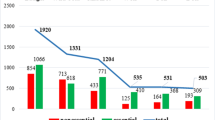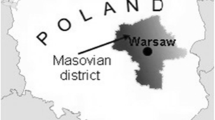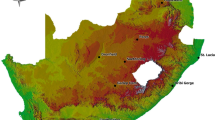Abstract
The concentrations of the elements copper (Cu), iron (Fe), manganese (Mn), and zinc (Zn) in hair of caged (in Maryland) and freeranging (in Puerto Rico) rhesus monkey populations were determined. Significant chronological age-related decreases were evident for the trace elements Mn and Zn in both populations (P<0.01) and for Cu and Fe in free-ranging monkeys (P<0.005). The only overall gender difference was higher hair Mn concentration in freeranging males than in females (P<0.03). There were no significant differences in hair Cu, Fe, or Mn related to pregnancy status. Hair Zn was lower in samples from pregnant than from nonpregnant monkeys from the caged monkeys (P≤0.05), but did not differe in the freeranging monkeys. Comparison of the two populations revealed that hair Zn levels were significantly higher in caged vs free-ranging animals (P<0.001). We attribute this higher hair Zn in the caged monkeys to contact and ingestion of Zn from their galvanized enclosures. Hair iron levels were significantly higher (P<0.001) in free-ranging monkeys, possibly as a result of Fe-rich soil ingestion from their environment. These data support continued investigation of the use of hair as an indicator of the exposure of large groups or populations to potentially high levels of specific minerals, and the use of nonhuman primates as models for the study of trace element deficiency and/or toxicity in humans.
Similar content being viewed by others
References
B. M. Marriott, J. C. Smith, R. M. Jacobs, A. O. L. Jones, and J. D. Altman, Hair content of calcium, magnesium and phosphorus in two populations of rhesus monkeys,Bio. Trace Element Res. (1996).
F. M. Loew, E. D. Olfert, and B. Schiefer, Chronic selenium toxicosis in Cynomolgus monkeys,Lab. Prim. Newsl. 14(4), 7–9 (1975).
H. H. Sandstead, D. A. Strobel, G. M. Logan, E. O. Marks, and R. A. Jacob, Zinc deficiency in pregnant rhesus monkeys: effects on behavior of infants,Am. J. Clin. Nutr. 31, 844–849 (1978).
H. Swenerton and L. S. Hurley, Zinc deficiency in rhesus and bonnet monkeys, including effects on reproduction,J. Nutr. 110, 575–583 (1980).
T. W. Clark and J. W. Huckabee, Elemental hair analysis of Japanese macaques transplanted to the United States.Primates 18(2), 299–303 (1977).
V. O. Hurme, Estimation of monkey age by dental formula,Ann. NY Acad. Sci. 85, 795–799 (1960).
V. O. Hurme and G. Van Wagenen, Basic data on the emergence of permanent teeth in the rhesus monkey,Proc. Am. Philos. Soc. 105, 105–140 (1961).
J. A. Gavan and C. Hutchinson, The problem of Age Estimation: a study using rhesus monkeys (Macaca mulatta),Am. J. Phys. Anthrop. 37, 69–82 (1973).
J. H. Kirk, Growth of maturingMacaca mulatta, Lab. Anim. Sci. 22(4), 573–575.
G. Van Wagenen and H. R. Catchpole, Physical growth of the rhesus monkey,Am. J. Phys. Anthropol. 14, 245–273 (1956).
D. J. Diersche, G. Weiss, and E. Knobil, Sexual maturation in the female rhesus monkey and development of estrogen-induced gonadotropic hormone release,Endocrinol. 94, 198–206 (1974).
B. M. Marriott, Time budgets of rhesus monkeys (Macaccua mulatta) in a forest habitat in Nepal and on Cayo Santiago, inEcology and Behavior of Food-Enhanced Primate Groups, J. E. Fa and C. H. Southwick, eds., Alan R. Liss, New York, pp. 125–149 (1988).
J. C. Smith, Jr., Methods in trace element research, inTrace Elements in Human and Animal Nutrition, vol. 1, W. Mertz, ed., Academic, New York, pp. 21–56 (1987).
W. R. Wolf, Quality assurance for trace element analysis, inTrace Elements in Human and Animal Nutrition, vol. 1, W. Mertz, ed. Academic, New York, pp. 57–78 (1987).
W. Craelius, R. M. Jacobs, and A. O. L. Jones, Mineral composition of brains of normal and multiple sclerosis victims,Proc. Soc. Exp. Biol. Med. 165, 327–329 (1980).
A. O. L. Jones, R. M. Jacobs, B. E. Fry, Jr., J. Jones, and J. H. Gould, Elemental content of predigested liquid protein products,Am. J. Clin. Nutr. 33, 2545–2550 (1980).
A. O. L. Jones, R. M. Jacobs, N. B. Ranney, and E. L. Summers, Commercial diagnostic hair analysis: accuracy or fantasy—a case study, inTrace Element Analytical Chemistry in Medicine and Biology, vol. 5, P. Bratter and P. Schramel, eds., Walter de Gruyter, New York, pp. 251–260 (1988).
G. Keppel,Design and Analysis. A Researcher's Handbook, Prentice-Hall, Englewood, NJ (1973).
G. W. Snedecor and W. G. Cochran,Statistical Methods, 6th ed., Iowa State University Press, Amesia, IA (1967).
B. J. Winer,Statistical Principles in Experimental Design, 2nd ed., McGraw-Hill, New York (1971).
L. Wilkinson,Systat: The System for Statistic, Systat, Inc., Evanston, IL (1987).
G. V. Iyengar and J. Woittiez, Trace elements in human clinical specimens: evaluation of literature data to identify reference values,Clin. Chem. 34(3), 474–481 (1988).
C. M. Bales, J. H. Freeland-Graves, S. Askey, F. Behmardi, R. S. Pobocik, J. J. Fickel, and P. Greenlee, Zinc, magnesium, copper, and protein concentrations in human saliva: age- and sex-related differences,Am. J. Clin. Nutr. 51, 462–469 (1990).
J. P. Creason, T. A. Hinners, J. E. Bumgarner, and C. Pinkerton, Trace elements in hair, as related to exposure in metropolitan New York,Clin. Chem. 21, 603–612 (1975).
L. M. Klevay, Hair as a biopsy material. II. Assessment of copper nutriture,Am. J. Clin. Nutr. 23, 1194–1202 (1970).
I. E. Ryan, J. Holzbecher, and D. C. Stuart, Trace elements in scale hair of persons with multiple sclerosis and of normal individuals,Clin. Chem. 24, 1996–2000 (1978).
H. H. Sky-Peck and B. J. Joseph, The ‘use’ and ‘misuse’ of human hair in trace metal analysis, inChemical Toxicology and Clinical Chemistry of Metals, S. S. Brown and J. Savory, eds., Academic, London pp. 159–163 (1983).
S. B. Deeming and C. W. Weber, Hair analysis of trace minerals in human subjects as influenced by age, sex and contraceptive drugs,Am. J. Clin. Nutr. 31, 1175–1180 (1978).
R. F. M. Herber, A. A. E. Wibowo, H. A. Das, R. J. Egger, W. van Deyck, and R. L. Zielhuis, Trace element levels in hair of eight-year-old children,Int. Arch. Occup. Environ. Health 53, 127–137 (1983).
L. D. MacDonald, R. S. Gibson, and J. E. Miles, Changes in hair zinc and copper concentrations of breast fed and bottle fed infants during the first six months,Acta Paediatr. Scand. 71, 785–789 (1982).
J. M. McKenzie, Alteration of the zinc and copper concentration of hair,Am. J. Clin. Nutr. 31, 470–476 (1978).
G. F. Gordor, Sex and age related differences in trace element concentrations in hair,Sci. Total Environ. 42, 133–147 (1985).
H. A. Schroeder and A. P. Nason, Trace minerals in human hair,J. Invest. Dermatol. 52, 71–78 (1969).
H. G. Petering, D. W. Yeager, and S. O. Witherup, Trace metal content of hair. I. Zinc and copper content of human hair in relation to sex,Arch. Environ. Health 23, 202–207 (1971).
S. N. Gershoff, R. B. McGandy, A. Nondasuta, U. Pisolyabutra, and P. Tantiwongse, Nutrition studies in Thailand. III. Trace minerals in human and rat hair,Am. J. Clin. Nutr. 30, 868–872 (1977).
A. Taylor, Usefulness of measurements of trace elements in hair,Ann. Clin. Biochem. 23, 364–378 (1986).
R. S. Gibson and M. S. Dewolfe, Changes in hair trace metal concentrations in some Canadian low birth weight infants,Nutr. Rep. Intl. 21, 341–349 (1980).
L. S. Hurley and C. L. Keen, Manganese, inTrace Elements in Human and Animal Nutrition, vol. 1, W. Mertz, ed., Academic, New York pp. 185–224 (1987).
K. M. Hambidge, C. Hambidge, M. Jacobs, and J. D. Baum, Low levels of zinc in hair anorexia, poor growth and hypogeusia in children,Pediatr. Res. 6, 868–874 (1972).
J. Erten, A. Arcasoy, A. Cavadar, and S. Cin, Hair zinc levels in healthy and malnourished children,Am. J. Clin. Nutr. 31, 1172–1174 (1978).
S. E. Fisher, N. W. Alcock, J. Amirian, and H. L. Altshuler, Neonatal and maternal hair zinc levels in a nonhuman primate model of the fetal alcohol syndrome,Alcohol. Clin. Exp. Res. 12(3), 417–421 (1988).
J. W. Huckabee, F. O. Cartan, and G. S. Kennington,Environmental Influence on Trace Elements in Hair of 15 Species of Mammals.ORNL-TM 3747, Oak Ridge National Laboratory, Oak Ridge, TN (1972).
A. S. Prasad, E. B. Schoomaker, J. Ortega, G. J. Brewer, D. Oberleas, and F. J. Oelshleyel, Jr., The role of zinc in man and its deficiency in sickle cell disease, inProgress in Clinical and Biological Research, vol. I:Erythrocyte Structure and Function, G. J. Brewer, ed., Alan R. Liss, New York, pp. 603–614 (1985).
M. D. Stevens, W. F. MacKenzie, and V. D. Anand, Influence of cage material on amount of zinc in blood of the rhesus monkey (Macaca mulatta),Vet. Pathol. 14, 508–509 (1977).
A. S. Prasad,Zinc Metabolism, 1st ed. Charles C. Thomas, Springfield, IL (1966).
K. M. Hambidge, N. F. Krebs, M. A. Jacobs, A. Favier, L. Guyette, and D. N. Ikle, Zinc nutritional status during pregnancy: a longitudinal study,Am. J. Clin. Nutr. 37, 429–442 (1983).
G. Van Wagenen, Body weight and length of the newborn laboratory rhesus monkey (Macaca mulatta),Fed. Proc. 13, 157–165 (1954).
B. Lönnerdal, C. L. Keen, C. E. Glazier, and J. Anderson, A longitudinal study of rhesus monkey (Macaca mulatta) milk composition: trace elements, minerals, protein, carbohydrate, and fat,Pediatr. Res. 18(9), 911–914 (1984).
K. M. Hambidge, Hair analysis: worthless for vitamins, limited for minerals,Am. J. Clin. Nutr. 36, 443–449 (1982).
L. M. Klevay, B. R. Bristrian, C. R. Fleming, and C. G. Neumann, Hair analysis in clinical and experimental medicine,Am. J. Clin. Nutr. 46, 233–236 (1987).
R. S. Gibson and I. R. Gibson, The interpretation of human hair trace element concentrations,Sci. Tot. Environ. 39, 93–101 (1984).
P. Mason and S. Zlotkin, Hair analysis—a critical review,Can. Med. Assoc. J. 133, 186–188 (1985).
G. V. Iyengar, Milestones in biological trace element research,Sci. Total Environ. 100, 1–15 (1991).
Author information
Authors and Affiliations
Rights and permissions
About this article
Cite this article
Marriott, B.M., Smith, J.C., Jacobs, R.M. et al. Copper, iron, manganese, and zinc content of hair from two populations of rhesus monkeys. Biol Trace Elem Res 53, 167–183 (1996). https://doi.org/10.1007/BF02784553
Received:
Revised:
Accepted:
Issue Date:
DOI: https://doi.org/10.1007/BF02784553




